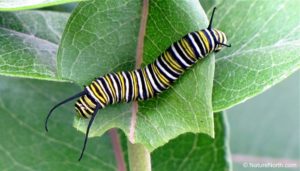The term “larva” refers to the growth stage of all insects with complete metamorphosis, while “caterpillar” specifically applies to butterflies and moths in this stage. Most scientists use the term larva. During this stage, monarchs do nearly all of their growing, consuming food constantly and taking few breaks. A monarch caterpillar grows 3,000 times its birth weight in less than a month.
The monarch larva undergoes five stages of development, known as “instars.” At the end of each instar, the caterpillar molts, shedding its skin to continue growing. With each stage, the caterpillar becomes larger and shows slight changes in appearance. The larva stage lasts 11-18 days, depending on temperature.
1st Instar

A newly-hatched monarch larva is pale green or grayish-white, shiny, and almost translucent, with no stripes or markings. Its head appears black with lighter spots around the antennae and below the mouthparts, and may be wider than the body. After hatching, the larva eats its eggshell (chorion) and then consumes clusters of fine hairs on the bottom of the milkweed leaf before feeding on the leaf itself in a circular motion, often leaving an arc-shaped hole.
2nd Instar

Second instar larvae display a clear pattern of black (or dark brown), yellow, and white bands. Their bodies no longer appear transparent and shiny. A distinguishing feature is the yellow triangle on the head with two sets of yellow bands around it. The hairs (setae) on their bodies are more abundant, shorter, and stubble-like compared to first instar larvae.
3rd Instar

The black and yellow bands on the abdomen of a third instar larva are darker and more distinct than those of the second instar, although the bands on the thorax remain indistinct. The triangular patches behind the head have become thin lines extending below the spiracle. The yellow triangle on the head is larger, and the yellow stripes are more visible. The first set of thoracic legs is smaller and closer to the head. Third instar larvae typically feed using a distinct cutting motion on leaf edges.
4th Instar

Fourth instar larvae have a distinct banding pattern on the thorax, not present in third instars. The first pair of legs is even closer to the head, and white spots on the prolegs become more conspicuous.
5th Instar

The body pattern and colors of the fifth instar larvae are even more vivid than in the fourth instar, with wider, almost velvety black bands. The front legs are much smaller than the other pairs and closer to the head. Distinct white dots are visible on the prolegs, and the body appears quite plump, especially before pupating.
Fifth instar monarch larvae often chew a shallow notch in the petiole of the leaf they are eating, causing it to fall into a vertical position. They move farther and faster than other instars, often venturing far from milkweed plants to find a pupation site.
All 5 Stages of Instars

